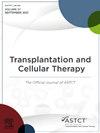优化多发性骨髓瘤的自体干细胞移植:强化化疗的影响。
摘要
背景:大多数符合移植条件的多发性骨髓瘤(MM)患者接受自体外周血干细胞采集(PBSC),使用G-CSF和按需普利沙佛(G±P)。化学动员(CM)可作为G±P失败后的挽救方案,或在自体外周血干细胞移植(ASCT)前清除残余肿瘤负荷。之前使用环磷酰胺为基础的CM疗法的研究并未显示出长期疗效:在我们中心,使用基于PACE或HyperCVAD方案的强化CM(ICM)已被用于减轻基于浆细胞负荷或MM相关生物标志物的 "过度 "残留疾病。鉴于非强化CM缺乏疗效,我们试图确定ICM对无事件生存期(EFS)的影响,无事件生存期是指死亡、疾病进展或计划外治疗升级:我们对 2020 年 7 月至 2023 年 2 月期间在本中心采集了自体 PBSCs 并打算立即进行 ASCT 的新诊断 MM 患者进行了回顾性研究。如果患者接受了串联自体移植或序贯自体-异基因移植、患有原发性浆细胞白血病、接受了非ICM治疗(即环磷酰胺和/或依托泊苷)或之前G±P动员失败,则将其排除在外。为了适当评估 ICM 对那些有可能接受 ICM 的患者的影响,我们采用了倾向得分匹配 (PSM) 方法,将 ICM 患者与根据与接受 ICM 最密切相关的辅助检查前因素进行匹配的非 ICM 患者进行比较:在确定的 451 名患者中,61 人(13.5%)接受了 ICM(基于 PACE 的患者,45 人;基于 hyper-CVAD 的患者,16 人)。ICM 后/ASCT 前,11 名患者(18%)因中性粒细胞减少性发热和/或感染需要入院。在51名可评估的患者中,总反应率为31%;但在55名可评估的患者中,46名(84%)的M-棘和/或受累FLCs有所下降。在使用纵向外周血流式细胞术进行评估的患者(8 人)中,有 5 名患者(63%)在 ICM 后清除了循环血液中的 PC。与非 CM 动员的患者相比,ICM 患者收集的 CD34+ 细胞中位数略多(10.8 vs 10.2 × 10⁶/kg,p=.018)。ASCT后的中位随访时间为30.6个月。在 PSM 多变量分析中,ICM 与 EFS 的显著改善相关(HR 0.30,95% CI 0.14 至 0.67,p=.003),但与 OS 的改善无关(HR 0.38,95% CI 0.10 至 1.44,p=.2)。ICM与ASCT后住院时间延长有关(+4.1天,95% CI,2.4至5.8,p结论:在一项涉及接受辅助治疗前检查时疾病负担过重的 MM 患者的匹配分析中,ICM 与 EFS 的改善密切相关。这种益处是以延长住院时间、增加发热天数、增加菌血症发生率以及增加辅助治疗后抗生素用量为代价的。我们的研究结果表明,部分 MM 患者可以考虑使用 ICM,但必须谨慎权衡其使用与额外毒性之间的关系。Most transplant-eligible multiple myeloma (MM) patients undergo autologous peripheral blood stem cell collection (PBSC) using G-CSF with on-demand plerixafor (G ± P). Chemomobilization (CM) can be used as a salvage regimen after G ± P failure or for debulking residual tumor burden ahead of autologous peripheral blood stem cell transplantation (ASCT). Prior studies utilizing cyclophosphamide-based CM have not shown long-term benefits. At our center, intensive CM (ICM) using a PACE- or HyperCVAD-based regimen has been used to mitigate “excessive” residual disease based on plasma cell (PC) burden or MM-related biomarkers. Given the lack of efficacy of non-ICM, we sought to determine the impact of ICM on event-free survival (EFS), defined as death, progressive disease, or unplanned treatment escalation. We performed a retrospective study of newly diagnosed MM patients who collected autologous PBSCs with the intent to proceed immediately to ASCT at our center between 7/2020 and 2/2023. Patients were excluded if they underwent a tandem autologous or sequential autologous-allogeneic transplant, had primary PC leukemia, received non-ICM treatment (i.e., cyclophosphamide and/or etoposide), or had previously failed G ± P mobilization. To appropriately evaluate the impact of ICM among those who potentially could have received it, we utilized a propensity score matching (PSM) approach whereby ICM patients were compared to a cohort of non-CM patients matched on pre-ASCT factors most strongly associated with the receipt of ICM. Of 451 patients identified, 61 (13.5%) received ICM (PACE-based, n = 45; hyper-CVAD-based, n = 16). Post-ICM/pre-ASCT, 11 patients (18%) required admission for neutropenic fever and/or infection. Among 51 evaluable patients, the overall response rate was 31%; however, 46 of 55 evaluable patients (84%) saw a reduction in M-spike and/or involved free light chains. Among those evaluated with longitudinal peripheral blood flow cytometry (n = 8), 5 patients (63%) cleared circulating blood PCs post-ICM. Compared to patients mobilized with non-CM, ICM patients collected a slightly greater median number of CD34+ cells (10.8 versus 10.2 × 10⁶/kg, P = .018). The median follow-up was 30.6 months post-ASCT. In a PSM multivariable analysis, ICM was associated with significantly improved EFS (hazard ratio [HR] 0.30, 95% CI 0.14 to 0.67, P = .003), but not improved OS (HR 0.38, 95% CI 0.10 to 1.44, P = .2). ICM was associated with longer post-ASCT inpatient duration (+4.1 days, 95% CI, 2.4 to 5.8, P < .001), more febrile days (+0.96 days, 95% CI 0.50 to 1.4, P < .001), impaired platelet engraftment (HR 0.23, 95% CI 0.06 to 0.87, P = .031), more bacteremia (OR 3.41, 95% CI 1.20 to 9.31, P = .018), and increased antibiotic usage (cefepime: +2.3 doses, 95% CI 0.39 to 4.1, P = .018; vancomycin: +1.0 doses, 95% CI 0.23 to 1.8, P = .012). ICM was independently associated with improved EFS in a matched analysis involving MM patients with excessive disease burden at pre-ASCT workup. This benefit came at the cost of longer inpatient duration, more febrile days, greater incidence of bacteremia, and increased antibiotic usage in the immediate post-ASCT setting. Our findings suggest that ICM could be considered for a subset of MM patients, but its use must be weighed carefully against additional toxicity.

 求助内容:
求助内容: 应助结果提醒方式:
应助结果提醒方式:


